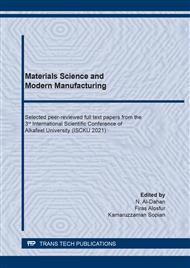[1]
T. Edvinsson, Optical quantum confinement and photocatalytic properties in two-, one-and zero-dimensional nanostructures, R. Soc. open Sci., vol. 5, no. 9 (2018) p.180387.
DOI: 10.1098/rsos.180387
Google Scholar
[2]
C. C. Price, N. C. Frey, D. Jariwala, and V. B. Shenoy, Engineering zero-dimensional quantum confinement in transition-metal dichalcogenide heterostructures, ACS Nano, vol. 13, no. 7 (2019) p.8303–8311.
DOI: 10.1021/acsnano.9b03716
Google Scholar
[3]
J. Liang, D. Chen, X. Yao, K. Zhang, F. Qu, L. Qin, Y. Huang, and J. Li, Recent progress and development in inorganic halide perovskite quantum dots for photoelectrochemical applications, Small, vol. 16, no. 15 (2020) p.1903398.
DOI: 10.1002/smll.201903398
Google Scholar
[4]
W. Xie, Photoionization and third-order susceptibility of a neutral donor in ZnS/InP/ZnSe core/shell spherical quantum dots, Phys. B Condens. Matter, vol. 449 (2014) p.57–60.
DOI: 10.1016/j.physb.2014.04.075
Google Scholar
[5]
X. Zhang, H.-O. Li, G. Cao, M. Xiao, G.-C. Guo, and G.-P. Guo, Semiconductor quantum computation, Natl. Sci. Rev., vol. 6, no. 1 (2019) 32–54.
Google Scholar
[6]
J. Cayao, M. Benito, and G. Burkard, Programable two-qubit gates in capacitively coupled flopping-mode spin qubits, Phys. Rev. B, vol. 101, no. 19 (2020) 195438.
DOI: 10.1103/physrevb.101.195438
Google Scholar
[7]
E. Afsaneh and M. B. Harouni, Robust entanglement of an asymmetric quantum dot molecular system in a Josephson junction, Heliyon, vol. 6, no. 7 (2020) e04484.
DOI: 10.1016/j.heliyon.2020.e04484
Google Scholar
[8]
G. Rodary, L. Bernardi, C. David, B. Fain, A. Lemaître, and J.-C. Girard, Real space observation of electronic coupling between self-assembled quantum dots, Nano Lett., vol. 19, no. 6 (2019) p.3699–3706.
DOI: 10.1021/acs.nanolett.9b00772
Google Scholar
[9]
L. Oroszlany, A. Kormanyos, J. Koltai, J. Cserti, and C. J. Lambert, Nonthermal broadening in the conductance of double quantum dot structures, Phys. Rev. B, vol. 76, no. 4 (2007) p.45318.
DOI: 10.1103/physrevb.76.045318
Google Scholar
[10]
M. A. Najdi, H. A. Jassem, and J. M. AL-Mukh, Electron tunneling through serially coupled double quantum dots: The coulomb blockade, in IOP Conference Series: Materials Science and Engineering, vol. 454 (2018) p.12043.
DOI: 10.1088/1757-899x/454/1/012043
Google Scholar
[11]
W. G. Van der Wiel, S. De Franceschi, J. M. Elzerman, T. Fujisawa, S. Tarucha, and L. P. Kouwenhoven, Electron transport through double quantum dots, Rev. Mod. Phys., vol. 75, no. 1 (2002) 1.
DOI: 10.1103/revmodphys.75.1
Google Scholar
[12]
A. K. Hüttel, S. Ludwig, H. Lorenz, K. Eberl, and J. P. Kotthaus, Direct control of the tunnel splitting in a one-electron double quantum dot, Phys. Rev. B, vol. 72, no. 8 (2005) p.81310.
DOI: 10.1103/physrevb.72.081310
Google Scholar
[13]
D. E. F. Biesinger, Thermally activated charge fluctuations in GaAs double quantum dots, University_of_Basel, (2014).
Google Scholar
[14]
M. A. Najdi, J. M. AL-Mukh, and H. A. Jassem, Model Parameterization for Coherent Manipulation in Spin Current through FM-QD1-QD2-FM, J. Phys.: Conf. Ser. vol. 1818 (2021) 012102.
DOI: 10.1088/1742-6596/1818/1/012102
Google Scholar
[15]
M. Lee, M.-S. Choi, R. López, R. Aguado, and J. Martinek, Two-impurity Anderson model revisited: Competition between Kondo effect and reservoir-mediated superexchange in double quantum dots, Phys. Rev. B, vol. 81, no. 12 (2010) p.121311.
DOI: 10.1103/physrevb.81.121311
Google Scholar
[16]
D. M.-T. Kuo, S.-Y. Shiau, and Y. Chang, Theory of spin blockade, charge ratchet effect, and thermoelectrical behavior in serially coupled quantum dot system, Phys. Rev. B, vol. 84, no. 24 (2011) p.245303.
DOI: 10.1103/physrevb.84.245303
Google Scholar
[17]
A. R. Ahmed, The Chemisorption of Hydrogen and Alkali Atoms on Graphene with and without Decoration, Ph. D. thesis, University of Basrah, Basrah, Iraq, 2017.
Google Scholar
[18]
Y. Nishikawa, O. J. Curtin, A. C. Hewson, D. J. G. Crow, and J. Bauer, Conditions for observing emergent SU (4) symmetry in a double quantum dot, Phys. Rev. B, vol. 93, no. 23 (2016) p.235115.
DOI: 10.1103/physrevb.93.235115
Google Scholar
[19]
Y. S. Liu, X. F. Yang, X. K. Hong, M. S. Si, F. Chi, and Y. Guo, A high-efficiency double quantum dot heat engine, Appl. Phys. Lett., vol. 103, no. 9 (2013) p.93901.
DOI: 10.1063/1.4819852
Google Scholar
[20]
X. Zhou, F. Qi, and G. Jin, Enhanced spin figure of merit in an Aharonov-Bohm ring with a double quantum dot, J. Appl. Phys., vol. 115, no. 15 (2014) p.153706.
DOI: 10.1063/1.4871542
Google Scholar
[21]
I. Weymann, Boosting spin-caloritronic effects by attractive correlations in molecular junctions, Sci. Rep., vol. 6, no. 1 (2016) 1–10.
DOI: 10.1038/srep19236
Google Scholar
[22]
F.-B. Yang, Spin-polarized transport through a hybrid Majorana quantum dot system coupled ferromagnetic leads, Phys. E Low-dimensional Syst. Nanostructures, vol. 109 (2019) p.164–168.
DOI: 10.1016/j.physe.2019.01.020
Google Scholar


